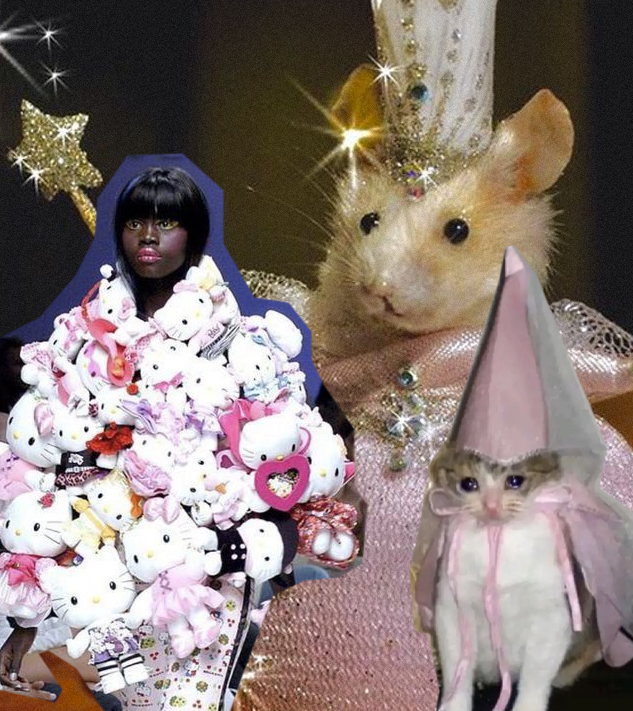Cuteness Overload! In Fashion, the Influence of Cute Shows No Sign of Slowing Down
Words: Hannah Tappin
Make it stand out
Outside London’s Somerset House, toddlers are clutching plush toys while twenty-somethings flaunt microskirts and Hello Kitty-charmed backpacks. They’re both equally cool. What unites all ages is a shared love of cute of course, which happens to be the focus of an exhibition at the venue. Die-hard cute lovers queue around the block to experience the whimsical delights of the Hello Kitty Café. A ninety-minute wait? That’s child's play for these devoted aficionados of all things adorable. In the world of cute, age, style, and background fade into irrelevance.
According to Claire Catterall, senior curator of the exhibition at Somerset House, cute isn’t just a passing fashion trend – it’s “the most prominent aesthetic of our times.” She likens it to “a tiny kitten waiting to pounce,” noting how its “power and influence has slowly crept up on us.”
And boy has it lunged onto the runway: From a whimsy wonderland set presented by Marc Jacobs in his latest show, to Prada’s AW24 collection, where Miuccia Prada champions the bow, that ultimate cutesy accessory, designers are celebrating cuteness. “It’s strange because, every single morning I have to decide if I am a 15-year-old girl or an old lady,” joked Prada in her recent Vogue profile. S.S. Daley's AW24 collection similarly enveloped us in childhood whimsy, particularly with the designer’s 'counting sheep' jumper featuring gambolling fluffy lambs. Beyond knitwear, it served as a nostalgic time machine, reminding us to cherish the magic of youth amidst the complexities of adulthood.
___STEADY_PAYWALL___
Extending beyond ready-to-wear, cute infiltrated haute couture collections, such as Simone Rocha for Jean Paul Gaultier’s SS24 couture collection (and her own AW24 collection too). Think baby pink hues, dainty bows, and ballerina silhouettes, all tangled up with Gaultier's playful nods to female sensuality – corsetry and detailed breast accents. It's a mesmerising mashup that ushers in a new era of cute fashion, where sweetness and seduction collide in a whirlwind of contradictions. As the fashion week spectacles unfold, it's not just about celebrating fashion's ongoing love affair with cute – it's about shaking things up, challenging norms and daring to reimagine adulthood.
Fashion melds sensuality with cute, with Rocha presenting its maturation. Cute comes from the Greek word acutus, implying sharpness of mind. It initially carried connotations of cleverness in the English language (1731). By contrast, in ancient Japan, 'utsukshi,' akin to 'kawaii' (Japanese for cute), referred to fragility and vulnerability, as described by Japanese author and poet Sei Shōnagon. Fast forward to today and our modern interpretation of cute is a vibrant tapestry woven from these diverse cultural threads. A blend of cleverness and charm, sharpness and sweetness; cute captivates hearts and wardrobes alike.
“As the fashion week spectacles unfold, it's not just about celebrating fashion's ongoing love affair with cute – it's about shaking things up, challenging norms and daring to reimagine adulthood.”
Sarah Gresty, course leader of BA Fashion Design at Central Saint Martins (CSM), sheds light on how this year's fashion students are boldly embracing cute to express their own identities and values. “From Barbie pink to girly-girl dresses,” she remarks to me over email, “students are wielding cute as a potent creative tool, veiling complex themes beneath a seemingly harmless exterior.” She notes cultural differences: “Asian students are increasingly drawing upon their upbringing and cultural heritage to portray a more radical creative perspective, while their Western counterparts are embracing cute as a nostalgic refuge.”
Just as cute captivates Gresty’s students, cutesy micro-trends steeped in feminine coding have ignited a frenzy on social media platforms, resonating to different fashion subcultures outside of the academic sphere. From the revival of twee styles to the resurgence of coquette-core and the enduring dark allure of cute aggression, these interpretations of the aesthetic transcends traditional boundaries in fashion. According to data shared by analytics guru @Style.Analytics, Pinterest searches for cute skyrocketed by 350% this January alone. The latest Pinterest Predicts 2024 report revealed a 140% surge in searches for card stickers and purse charms, fuelling the forecasted trend of cute coins – a phenomenon where consumers cute-ify their finances.
Reflecting on the viral sensation of fashion designer Sandy Liang’s ‘little girl dressing’ aesthetic, Anna Maria Somma, a brilliant young Italian MA student studying Fashion Histories and Theories at Central Saint Martins, tells me that “fashioning girlhood goes beyond simply putting a bow on it”. Instead, she argues, “Openly embracing the aesthetic elements associated with girlhood instead of rejecting them allows us to reclaim femininity as an intellectually generative space on par with masculinity.” Somma draws on the pioneering ideas of Judith Butler, a philosopher and gender theorist acclaimed for her contributions to gender performativity and queer theory, who argues that our current infatuation with cuteness holds profound significance. She contends that the prevalence of cuteness in 2024 serves as a deliberate way of “challenging societal notions of identity that previously relegated the feminine aesthetic as superficial.”
Also serving up a fresh perspective on our obsession with cuteness is Thea Von Engelbrechten, mastermind behind the viral @SylvanianDrama account. She explores the world of sinister cute by showcasing childhood characters in offbeat scenarios that strike a chord with fashion aficionados. Von Engelbrechten explains to me that, “It's all about the quirky blend of childhood nostalgia and the harsh reality of adult life, creating a hilariously twisted juxtaposition that's impossible to resist.” This concept finds resonance in the resurgence of slogan baby tees, spotted both on the runways and in street style since last summer, likely to carry on into the summer ahead.
In an era full of fleeting fashion trends, Still Cute Though looks like being around longer than one might expect. Like fashion itself, cute offers a sanctuary for self-expression and navigating life's intricate twists and turns. Fashion and cuteness, with their paradoxical qualities, mirror our imperfect yet beautiful existence.


